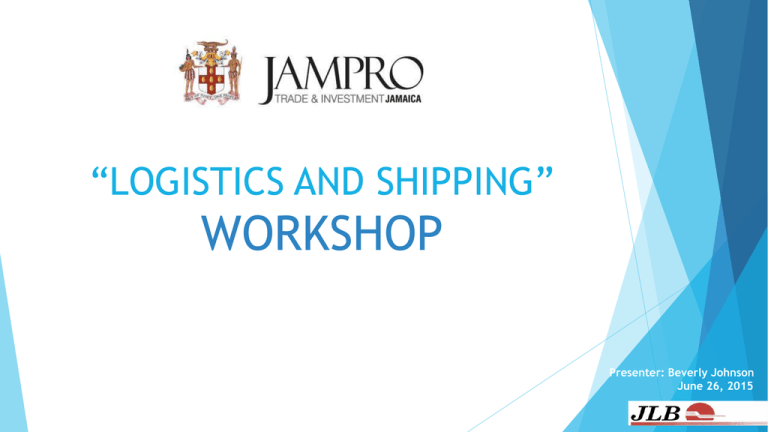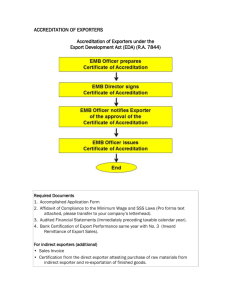Click here to download.
advertisement

“LOGISTICS AND SHIPPING” WORKSHOP Presenter: Beverly Johnson June 26, 2015 UNDERSTANDING: Costing exports Trade Agreements and their requirements (considerations for key markets e.g. Europe & EUR 1 Form) Proforma invoice versus commercial invoices Understanding Inco-terms Transportation and logistics Shipping requirements (modes of shipment) Legal aspects of shipping Choosing a suitable carrier Costing for Export There are many factors involved in costing for an export transaction and these are not relevant to domestic sales. To derive the real costing for export, you should have a cost analysis sheet completed to establish that all related cost pertaining to the export transaction are listed and built into the cost of products for exports. This way quotations are prepared correctly and accurately. The shipper is not loosing out and the buyer is not over-charged Cost for export vs Pricing Export costing should not be confused with pricing. Costs: The total of all expenses associated with producing and selling a product overseas. Price: The amount for which the exporter sells the product and is determined by the exporter’s marketing strategy. Margins: The difference between the total cost per unit and the export selling price which is determined by the producers/exporter/supplier’s corporate objectives. EXPORT COSTING WHAT’S SHOULD BE INCLUDED PRIMARY COST SECONDARY COST FORMULATION & MODIFICATION (Labelling, re-packaging, rebranding etc.) Placement of a Product into a marketplace (5Ps – Price, place, products, promotion, people) CREDIT TERMS – AGREED INTEREST RATE Bank Charges Utilities WAREHOUSING & DISTRIBUTION HR & Training PORT FEES** EXPORT ADMINISTRATION Insurance Risk (depending on terms) FREIGHT (AIR, RAIL, LAND OR SEA) Quality Controls COST OF RAW MATERIAL COST OF MANUFACTURING PACKING & BRANDING FORMULATION AND MODIFICATION (as requested by a buyer) COSTING EXPORTS Will the product be competitive? ORIGIN COST (JAMAICA) COST OF GOODS INLAND TRANSPORT EXPORT PROCESSING JAMPRO REGISTRATION PORT/AIRLINE FEES ORIGIN TERMINAL HANDLING FEE WAREHOUSING/CONTAINER DESTINATION COST TRANSHIPMENT INSPECTION DESTINATION TERMINAL HANDLING FEE CUSTOMS CLEARANCE STORAGE/DEMURRAGE ETC CUSTOMS DUTY/TAXES MARINE INSURANCE INLAND HAULAGE FREIGHT (AIR OR SEA) WAREHOUSING OBTAIN CERTIFICATES OF ORIGIN DISTRIBUTORS’ MARK-UP CERTIFICATES OF ORIGIN WHAT IS A EUR 1 CERTIFICATE? An EUR1, also known as a ‘movement certificate’, enables importers in certain countries to import goods at a reduced or nil rate of import duty under trade agreements between the EU and beneficiary countries. The condition of “Origin" is that the products must have been completely manufactured, processed or transformed in a member country. The EUR.1 is used to certify the origin of a product, and if applicable, benefit from favorable trade terms (tariffs mainly) under a preferential trade policy of the European Union (EU). Without a certified EUR 1 Certificate from the authorizing body (eg: Jamaica Customs), goods entering EU markets will be levied with the rate of duties applicable to the products and preferential treatment will apply. The full duty and taxes if chargeable are payable A EUR 1 Certificate must be accompanied with the Supplier’s Invoice for certification to be done. Shipping & Logistics Shipping is the physical process of transporting commodities and merchandise goods and cargo via sea or air) Logistics is the management of the supply chain in the flow of goods between the point of origin and the point of consumption in order to meet market demands CHOOSING A SUITABLE CARRIER EXPORTING YOUR PRODUCT? YOU MUST DETERMINE THE MOST SUITABLE MODE OF TRANSPORT I. SEA (TO INCLUDE THE NVOCC) or II. AIR (TO INCLUDE AIR COURIER) or III. MULTIMODAL (TO INCLUDE TRANSHIPMENT) FACTORS WHICH DETERMINES THE SUITABLE MODE FREQUENCY OF SERVICE TRANSIT TIME SHELF LIFE OF THE PRODUCT INLAND TRANSPORT TRANSHIPMENT POSSIBILITIES LEGAL ASPECTS OF SHIPPING Understanding the 1.Terms of the Bill of Lading 2.Terms of the Airway Bill 3.Terms of the Multimodal Bill of Lading 4. Pro-forma/Commercial Invoice PROFORMA INVOICE VS COMMERCIAL INVOICE What’s the difference? A Pro forma Invoice (or estimated invoice) is the document commonly used as preliminary invoices with a quotation, which shows negotiation between reached between the seller and the buyer. Its an estimated invoice sent by a seller to a buyer in advance of a shipment or delivery of goods. It notes the kind and quantity of goods, their value, and other important information such as weight and transportation charges, terms of sales and terms of delivery. Pro forma invoices. It is not a confirmation of a Sales Agreement PROFORMA INVOICE VS COMMERCIAL INVOICE A Commercial Invoice is a document used in foreign trade. It is used as a customs declaration provided by Supplier/Shipper It’s used for exporting goods across international borders Information on all the parties involved in the shipping transaction Detailed description of goods being transported, quantity & Value The country of manufacture The Harmonized System codes for each item being shipped Must also include a statement certifying that the invoice is true, and a signature. A commercial invoice is used to calculate tariffs, based on the CIF value for customs purposes of duty and taxes payable CONSIDER THE MOST SUITABLE INCOTERMS TERMS OF DELIVERY – A standardized set of terms intended to reduce or remove altogether uncertainties arising from different interpretation of the rules in different countries for the movement of goods and where the responsibility change hands from the seller to the buyer EX WORKS or FOB or C&F or CIF or DDU INCOTERM RULES Contact info. BEVERLY JOHNSON INTERNATIONAL LTD (Jamaica & the UK) EMAIL: beverlyj@jlbshipping.com



